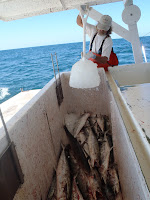 Two primary species of mackerel are harvested in Florida waters. The King mackerel (Scomberomorus cavalla) and Spanish mackerel (Scomberomorous maculatus) are two of the most important fishery species in the state. In 2011, both species were among the state’s top 10 commercial finfish species for landings and dockside value, worth more than $10 million combined.
Two primary species of mackerel are harvested in Florida waters. The King mackerel (Scomberomorus cavalla) and Spanish mackerel (Scomberomorous maculatus) are two of the most important fishery species in the state. In 2011, both species were among the state’s top 10 commercial finfish species for landings and dockside value, worth more than $10 million combined. As any south Florida angler knows mackerel are also among the most popular recreational fishes. They’re fairly common, put on a good fight, and taste good too. Sixty-eight percent of the total allowable catch is allocated to the recreational fishery and King and Spanish mackerel are both among the top five recreationally harvested species in the state (by weight).
King and Spanish mackerel are healthy sources of protein, Omega-3s, selenium, and B vitamins. However, it is essential that they are handled properly once landed as they have been identified by the U.S. Food and Drug Administration (FDA) as being capable of causing scombrotoxin poisoning. Other potential fish include:
What is scombrotoxin poisoning?
Scombrotoxin or histamine poisoning occurs when histamine and other biogenic amines are permitted to build up as a result of bacterial spoilage associated with time/temperature abuse. In the U.S. it is one of the most common illnesses caused by seafood, but it may also be prevented with proper handling and cooling. Biogenic amines, including histamine, are natural chemicals that can form in fish anytime during harvest, preparation and storage, though growth is more rapid at high temperatures. These amines may begin to develop after the fish dies, and will increase if the fish is left in the water too long after death, or if it is not adequately chilled immediately after it is brought on board. Symptoms
Once histamine is formed it does not go away and cannot be eliminated by washing, cooking or freezing. Therefore, prevention is the only way to assure that histamine is not present in fish. Any fish that is showing signs of spoilage should be discarded, however even if a fish smells or looks good histamine may still be present and illness is possible. In most cases, the illness occurs very quickly and is relatively short-lived. While severe reactions are rare, symptoms are very uncomfortable and include flushing of the face and neck, tingling sensation of the tongue, headaches or dizziness, vomiting and/or diarrhea. Rapid chilling of fish immediately after death is the most important strategy for preventing the formation of scombrotoxin. Formation of biogenic amines is drastically reduced by cooling fish to 40° F (internal) and fish should be packed in ice, ice slush, chilled seawater or chilled brine as quickly as possible. Since larger fish take longer to cool than smaller fish evisceration (removal of the guts) of larger fish is a good way to help remove the bacteria that causes formation of biogenic amines. Evisceration must be done carefully and the gut cavity should be filled with ice or cooling media to quicken internal chilling.
References
1. Fish and Fishery Products Hazards and Controls Guidance (FDA Hazards Guide)(4th Edition). 2. FDA Bad Bug Book: http://www.fda.gov/downloads/Food/FoodSafety/FoodborneIllness/







